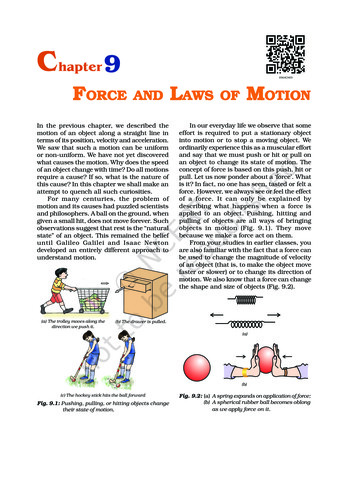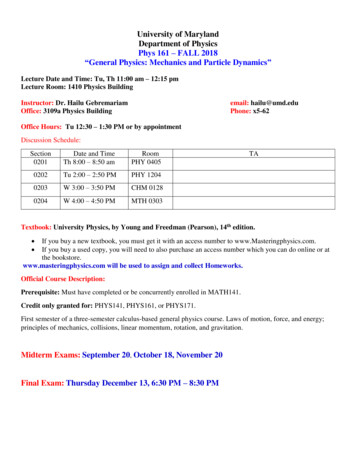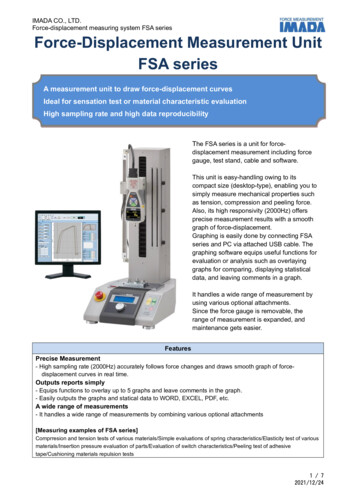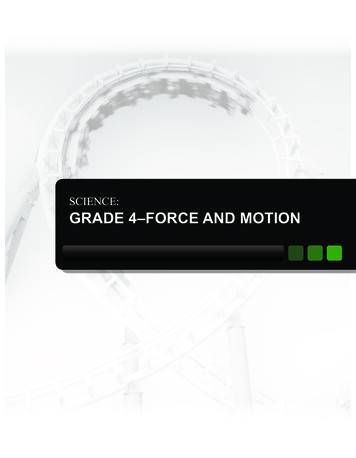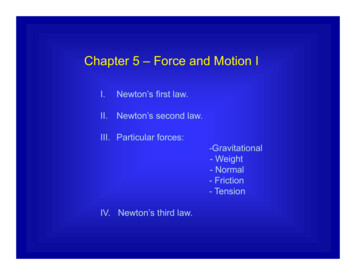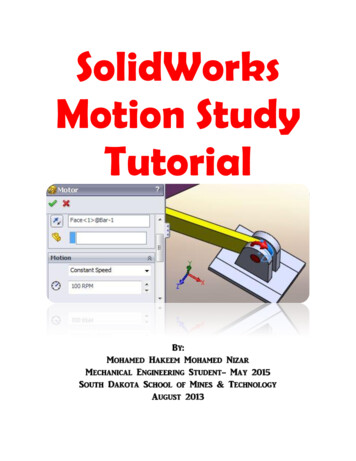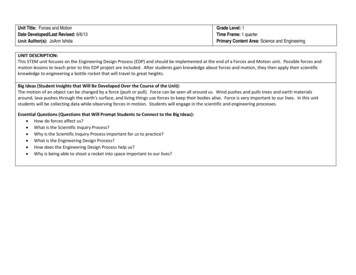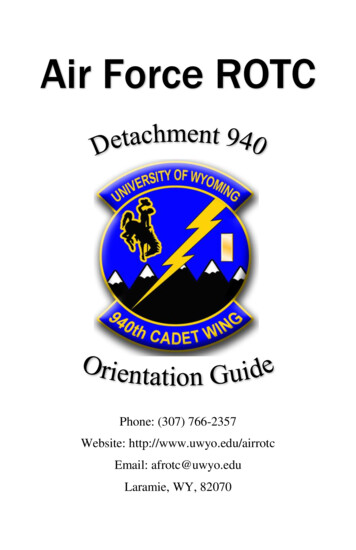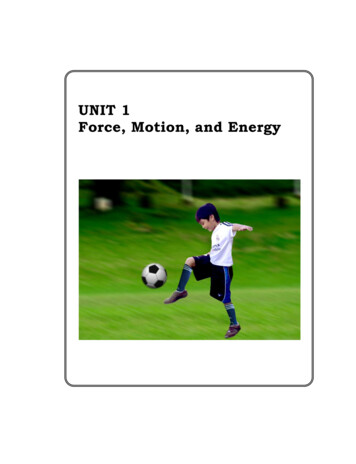
Transcription
UNIT 1Force, Motion, and Energy
2
UNIT 1: Force, Motion, and EnergyOverviewIn Grade 7, students learned that energy exists in different forms and it canbe transformed from one form to another. They also learned that energy can betransferred from one object or place to another in different ways. In Grade 8,students deepen their understanding of the different forms of energy by describinghow the energy transferred affects, or is affected by, objects.This unit has six modules. The first two modules discuss the effects of energyat the macroscopic level while the next four modules tackle these effects at theparticle level. Module 1 focuses on the idea that if a net or unbalanced force acts onan object, the motion of the object will change. Module 2 picks up this idea andexplains how the application of force can do work on an object with a correspondingtransfer of energy. Module 3 describes the effects of heat on objects involved inenergy transfer and explains these effects at the particle level. Module 4 deals withhow energy affects the movement of charges in electrical circuits. Module 5discusses how energy propagates through solids, liquids, and gases. It alsodescribes how the speed of the energy transferred varies with some factors, such astemperature. Module 6 describes how the different colors of light differ in terms oftheir frequency and energy.Most of the topics in this module are dealt with qualitatively in order forstudents to have a basic understanding of the concepts. Some tasks includemeasurements and computations in order to illustrate the relationship amongquantities. Through the activities included in each module, it is also aimed to makestudents gain interest in these topics and motivate them to learn more in thesucceeding grade levels.The following ideas are expected to be developed among the students: Energy is transmitted in the form of heat from one place to another due totemperature differences or in the form of mechanical work (potential andkinetic energy).Energy affects objects. The effects are manifested in the changes thatobjects undergo. For example, energy can cause changes in the motion ofobjects, particles, or charges. It can also cause changes in some propertiesof matter such as temperature. The amount of change depends on theamount of energy transferred.The energy transferred can also be affected by the nature or kind of materialsinvolved.3
4
Unit 1MODULE1FORCES AND MOTIONAfter learning about the ways by which the motion of an object can bedescribed and represented in grade 7, students will now study the motion of objectsusing the concept of force. They will describe the effects of forces on an object anddetermine the relationship between the net force acting on an object and itsacceleration due to this force.Key questions for this moduleDo forces always result in motion?What are the conditions for an object to stay at rest, to keep moving atconstant velocity, or to move with increasing velocity?How is force related to acceleration?This module aims to address the following misconceptions related to force andmotion:1. If an object stays at rest, there is no force acting upon it.2. An object continues to move at constant velocity because a constantforce acts on it.3. If the speed of an object increases, its acceleration also increases.4. Objects move because they have a force; they stop when their force isalready used up. (Force is thought to be a property of a material)5
Start the module by eliciting students’ prior knowledge of force and motion.Questions such as the following may be asked: What makes objects move the way they do?Why do objects move in different ways? Why are some objects fasterthan the others?What makes objects stay in place?Note that there are no correct or wrong answers yet at this point. Just take note oftheir answers and go back to some of them after they finish the module.Balanced and Unbalanced Forces1. To introduce the concept of FORCE, place a ball or any object on top of a tableand ask:a)b)c)d)e)Will this object move by itself?How can we make this object move?While it is moving, how can we make the object speed up or slow down?How can make it stop?How can we make it change its direction?Ask students to describe or demonstrate how they can achieve the givenconditions above. This will lead them to realize that to make the object move,speed up, slow down, stop, or change its direction, it has to be pushed or pulled.The motion of an object can be changed if we apply FORCE on it2. Pose another question: Consider again this ball here on top of the table. Sincethis ball stays at rest (meaning it does not change its motion) can we say thatthere is/are no force/s acting on it?6
Activity1Forces on objects at rest In this activity, students are asked to identify the forces acting on objects at rest.This is a very simple activity and the materials are readily available, so studentscan work on it individually or in pairs. This is to ensure that everybody isparticipating during the activity proper. At this point, students need not to explain why the objects stay in place. Theymay explain this after they finish doing Activity 2. During the post activity discussion, students can be asked to recall what theylearned in the previous grades about the force of gravity. They may be asked toshow or cite examples that demonstrate the presence of the force of gravity onEarth. If there is enough time, discuss more about gravitational force. Emphasisshould be given on the following ideas:-Gravitational force is the attraction between any two bodies with mass.-Gravitational force increases with mass. If the mass of either objectincreases, the gravitational force between them also increases.-As the Earth attracts objects around it, these objects also attract the Earth.But the Earth is much more massive than them that is why their attraction isnot as great as the gravitational pull of the Earth.-All things on Earth fall (or are attracted) towards the center of the Earth.7
Answers to QuestionsTensionforceSituation 1: Hanging penQ1.The pen is at rest.Q2.Yes. The forces acting on the pen are thetension force (the force exerted by the stringon the pen) and the force of gravity.Force ofgravityHanging penQ3.When the string was cut, the pen falls to theground. The force of gravity makes theobject fall down.Normal force / Forceexerted by the tableon the bookSituation 2: Book on a tableQ4.The book is at rest.Q5.Yes. The forces acting on the book arethe force exerted by the table on thebook and the force of gravity.Q6.No, the book stays at rest. The bookmay be moved by pushing it on one sideonly.Force ofgravityBook on a tableActivity2Balance of forcesThe aim of this activity is to help the students understand how the forcesacting on the objects in Activity 1 prevent them from moving. In case the number of spring balance is not enough, each group can work on thefirst part of the activity first using two spring balances. Then they can be asked to8
join with another group to complete the 4 spring balances needed for the fourholes around the board. During the post activity discussion, the students must realize that there are stillforces acting upon objects at rest. But these forces balance each other therebycausing the objects to stay in place. Emphasize the following ideas:-If two forces acting on an object are equal in magnitude but opposite indirection, they are considered as balanced forces. These forces must liealong the same line.-If the forces acting on an object are balanced, the object either stays at restor continues to move at constant velocity.-If the forces acting on an object are unbalanced, the motion of the object willchange. This concept was discussed in the module using the rolling ball asan example. Emphasize that the ball slowed down and eventually stoppednot because its force was already used up nor the force acting on it wascontinuously decreasing (misconceptions). The ball slowed down andstopped because an unbalanced force caused it to change its motion. Thatunbalanced force is friction. This can be reiterated when Newton’s First Lawof Motion is discussed.Answers to QuestionsQ7.The forces are equal in magnitude but opposite in direction.Q8.If the lines of action of the forces are extended, they meet at a single point.Note: At this point, the term “concurrent forces” may be introduced. When the linesof action of the forces acting on an object meet at a single point, they areconsidered as concurrent forces. When the forces acting on an object areconcurrent, the object does not move nor rotate.Concept check:1.2.3.Fnet 20 unitsFnet 5 units. The object will move in the direction of the 10-unit force (largerforce).Fnet 0. The object will not move.9
Newton’s Three Laws of Motion If needed, introduce first Isaac Newton to the class. Discuss briefly some ofhis significant contributions especially in the field of physics. e.g. Newtoncombined his idea and the ideas of the other scientists like Galileo to give usa more unified picture of how our universe works. He formulated the laws ofmotion and gravitation. Through his three laws of motion, we can describeand predict the movement of everything around us.Activity3Investigating inertiaThis activity demonstrates how the inertia of an object affects its motion.Inertia is the tendency of the body to resist changes in its state of motion. This isdescribed through Newton’s First Law of Motion, also referred to as Law of Inertia.Teaching Tips After discussing the result of the activity, relate the Law of Inertia to theprevious discussion on balanced and unbalanced forces. Emphasize that ifan object is acted upon by balanced forces, its motion or its velocity will notchange. Since acceleration is defined as the change in velocity over time,then we can say that the object will not accelerate. It will only accelerate if theforces acting on it are unbalanced. This is what the Law of Inertia is all about.It states that, “An object will stay at rest or move at constant velocity unlessan unbalanced external force acts on it.”If time permits, discuss also the effect of mass on inertia: the greater thebody’s mass, the greater will be its inertia.For the application part, relate the concept of inertia to students’ experienceswhile riding a vehicle. Then discuss the importance of using a seatbelt.Answers to QuestionsCoin DropQ9.When we slowly pulled the cardboard, the coin on top moved with thecardboard.10
The frictional force acting between the coin and the cardboard caused thecoin to stay on top of the cardboard and move with it.Q10.When the coin was flipped quickly, the cardboard moved forward but the coindid not move with it. When the cardboard was removed from underneath it,the coin dropped into the glass.The coin did not move forward with the coin because of the tendency of thecoin to stay at rest (inertia).Stack of CoinsQ11.When we hit the bottom coin with the edge of the ruler, it moved out from thepile of coins but the other coins stayed in place. The inertia of the coins hascaused them not to move out with the coin that was hit by the ruler.Activity4Force and accelerationIn this activity, students will describe the relationship between the unbalancedexternal force acting on an object and its acceleration by analyzing tape charts. If the materials are available, try to demonstrate how the data or tape chartswere obtained. Hang four identical rubber bands from one end of a woodenbar as shown in Fig. 1. Then mark on the wooden bar the position where therubber bands should be stretched (Fig. 2). When the rubber band isstretched, it pulls with it the cart. Make sure that the person holding thewooden board with rubber bands is free to move and ready to run, if neededto maintain the length by which the rubber band is stretched while pulling thecart. This is to ensure that the force acting on the cart is constant. Thenumber of rubber bands used to pull the cart is related to the amount of forceacting on the cart. If the number of rubber bands is changed, say doubled,the force acting on the cart is considered also to be doubled.Figure 1Figure 211
Since they do not need to perform the activity, students can be asked to work onthe tape charts (Figure 3) individually or in pairs. Note that their measurementsmay differ even if they are provided with the same copies of the tape charts. Thisis why they are asked to compute for the acceleration of the cart at least threetimes using different values of average velocity. Then they will just get theaverage. Relate Newton’s Second Law of Motion, also called Law of Acceleration, to thepreviously discussed topics, particularly on the effects of unbalanced forces onthe motion of objects. Since the law of acceleration quantifies the relationship among mass, force, andacceleration, it is but necessary to discuss also the effect of mass of the objecton its acceleration. As the mass of the object increases, with the same amount offorce applied, its acceleration also increases. To state in another way, if thesame force acts on two bodies of different masses, the acceleration of the bodywith lesser mass is greater than the acceleration of the body with greater mass.Answers to QuestionsTape chart analysisQ12.We noticed that the lengths of the strips in all the tape charts are inincreasing order.In terms of the difference, we noticed that the amount of change in length ofthe strips differs among the tape charts. It is greatest in F 4 units.Q13.The increase in lengths of the strips suggests that the average velocity of thecart at equal time interval increases.The cart is accelerating.This is also true to all other tape charts.Q14.The increase in length of each strip from one strip to another is of equal size.This indicates equal changes in the velocity of the cart at equal periods oftime when the force acting on it is constant.Yes, this is also true with the other tape charts.Q15.The increase in length of the strips varies among the four tape charts. Theamount of change increases as the units of force increases.The increase in length is greatest in F 4 units and least in F 1 unit.Q16.When the dots on top of the strips are connected, a straight line was formed.Yes, the same pattern exists for the other tape charts.12
Quantitative analysisQ17.The computed values of vave are increasing. The cart is accelerating.Q18.The computed values of v are equal (or almost equal or very close).This means that the cart is accelerating uniformly or its acceleration isconstant.Q19.The computed values of acceleration are equal (or almost equal).Q20.The acceleration of the cart increases with the net or unbalanced forceapplied on it. Or as the amount of force applied on the cart increases, theacceleration of the cart also increases.Activity5Action-reactionThe Newton's third law of motion, or sometimes called as Law of ActionReaction, describes the relationship between the forces that two bodies exert oneach other. In this activity, students should realize that these forces are equal inmagnitude but opposite in direction. Make clear the difference between this pair of forces and the previouslydiscussed balanced forces. Emphasize that this pair of forces are acting ondifferent bodies, so they do not cancel each other out.Answers to QuestionsQ21.(answer may differ, but the values should be equal)These values represent the amount of pulling force that we exerted on eachother.Q22.The forces that we exerted are in opposite directions.Q23.(The readings this time should be greater than the previous ones)Q24.We increased the force that we exerted on each other.Q25.(readings may vary)Q26.The forces are of opposite directions.13
Figure 3: Tape charts14F 1 unitF 2 unitsF 3 unitsF 4 units
Solutions:For F 1 unitFor F 2 unitsV1 2.5cm/0.10s 25 cm/sV1 4.5cm/0.10s 45 cm/sV2 3.0cm/0.10s 30cm/sV2 5.5cm/0.10s 55cm/sV3 3.5cm/0.10s 35cm/sV3 6.5cm/0.10s 65cm/sV4 4.0cm/0.10s 40cm/sV4 7.5cm/0.10s 75cm/sV5 4.5cm/0.10s 45cm/sV5 8.5cm/0.10s 85cm/sSolving for aSolving for a2v 2 v 1 30cm/s 25cm/s 50cm/st0.10sv 3 v 2 35cm/s 30cm/s2a2 50cm/st0.10s2v 2 v 1 55cm/s 45cm/s 100cm/st0.10sv 3 v 2 65cm/s 55cm/s2a2 100cm/st0.10saave 50cm/s 2a ave 100cm/s 2For F 3 unitsFor F 4 unitsV1 8.5cm/0.10s 85 cm/sV1 14.5cm/0.10s 145 cm/sV2 10cm/0.10s 100cm/sV2 16.5cm/0.10s 165cm/sV3 11.5cm/0.10s 115cm/sV3 18.5cm/0.10s 185cm/sV4 13cm/0.10s 130cm/sV4 20.5cm/0.10s 205cm/sV5 14.5cm/0.10s 145cm/sV5 22.5cm/0.10s 225cm/sSolving for aSolving for aa1 a1 a2 v 2 v1t a1 2v v 1 165cm/s 145cm/s100cm/s 85cm/s 200cm/s 150cm/sa21 2t0.10s0.10sv v 2 185cm/s 165cm/s22v 3 v 2 115cm/s 100cm/s 200cm/s 150cm/s a 2 3t0.10st0.10sa ave 200cm/s 2aave 150cm/s215
Data for Table 1ForceF 1 unitF 2 unitsF 3 unitsF 4 units# of rubber bands1234Acceleration50 m/s2100 m/s2150 m/s2200 m/s2Acceleration200015001000501234ForceFigure 4: Graph of force vs accelerationReferencesUP NISMED. (2002). Practical Work on High School Physics: Sourcebook forTeachers. UP NISMED. Quezon City16
Unit 1MODULE2WORK AND ENERGYIn this module, students will learn about motion from the perspective of workand energy. The concept of energy is one of the most important concepts in physics.The students have been studying about it since Grade 3 up to Grade 7. They havelearned that energy takes many forms; there are different sources and uses ofenergy; and energy can be transferred.The module starts with a discussion about work. In the first activity, they willexplain whether a situation represents an example of work. It is followed by adiscussion about work and energy, and then about kinetic and potential energy. Inthe second activity, students will construct a toy that demonstrates how a rubberband ‘stores’ energy. The last activity puts together the concepts of work, energy andpower.Key questions for this moduleWhat is work?What is energy?How are work, energy and power related?What is work?Figures 1 to 3 in the student’s module shows different situations. Ask thestudents to identify the one doing the work and on which object the work is done.The students should be able to arrive at the concept that work is done on anobject when the force applied to it covers a distance in the direction of the appliedforce.17
Activity1Is there work done?In this activity, students will analyze the situations shown in the illustrations.For them to explain if the situations represent examples of work they should be ableto identify the one doing the work and on which object the work is done. They shouldalso look into the direction of force exerted relative to the direction of the movementof the object or the distance covered by the applied force.Teaching Tips1. Ask the students what’s the first thing that comes to their mind when theyhear the word work.2. Let them look for the meaning of work in a dictionary.3. Recall the lesson about force in Module 1.Answers to Questions A girl is pulling her toy car.Yes, the situation is an example of work. The work is done by the girl on thecart. The force exerted by the girl in pulling the toy car is in the same directionas the distance covered when the force is applied. A man is lifting a box to be placed on a table.Yes, the situation is an example of work. The work is done by the man on thebox. The force exerted by the man is upward and the box is displacedupward. A girl carrying a bag walks down the street.No, the situation is not an example of work. There is force (the shoulderpushes up the bag) and there is displacement (the bag is movedhorizontally). However, the line of action of the force and the displacementare not parallel but perpendicular. The distance covered is not along thedirection of the applied force.18
A mango fruit falling from the branchYes, the situation is an example of work. The work is done by the force ofgravity on the mango. In this case, the mango loses energy as you will findout in the discussion of potential energy.Calculating workThe students are given the equation of work in their module. However, theequation can only be used if the force is applied horizontally (pushed across the flooror ground) or vertically (lifted above).forceforceddFigure 1. Equation for solving workThe equation of work for forces at an angle is not introduced to the studentsbecause they have not yet taken up trigonometric functions in their mathematicsclass. However, if the students ask how to solve for work if the force is at an angle,you may also show the equation.forceFigure 2. Equation for solving work if the force is at an angle19
Answer to the problem:A book which has a mass of 1 kg is on the floor. If the book is lifted from thefloor to the top shelf which is 2 meters from the floor, how much work is done?Work is a Method of Transferring Energy In Grade 7, students learned that there are different ways by which energy canbe transferred from one place to another. This time, they will learn that work is ameans of transferring energy from one object to another. Is there work done on the ball? In the bowling game described in the student’smaterial, the work is done by the person on the ball to just start it moving.Because of the work done to the ball, it gained ‘something’ that enables it tomove. That ‘something’ that was transferred to the ball is called energy. Theenergy became energy of motion of the ball. What can a moving ball do? A moving ball has energy. When it strikes the emptyplastic bottle, it can push it through a distance. Thus, work is done by the ball onthe empty plastic bottle. Since work is done on the bottle, energy is transferred toit. If energy can be transferred, what happens to the energy of the one doing thework and to the object on which work is done? The one doing the work losesenergy and the object on which work is done gains energy. When work is doneby an object, the object loses energy; when work is done on an object, the objectgains energy. In the bowling game the students played, the one rolling the ballloses energy while the ball gains energy. When the moving ball strikes the emptyplastic bottle it loses energy while the plastic bottle gains energy.20
Clarify to the students that it is energy and not force that is transferred whenwork is done. You may also show or demonstrate a billiard game wherein one ball hits anotherball.Kinetic Energy The energy of a moving object is called energy of motion or kinetic energy (KE).How the equation of KE is derived is shown in the student’s module. The KE of an object depends on its mass and velocity. What will happen to theKE of an object if its mass is doubled but the velocity remains the same? The KEwill be doubled. How about if the velocity is doubled but the mass remains thesame? The KE is proportional to the square of the speed, thus if the speed isdoubled, the KE will be quadrupled.Answer to the problem:A 1000 kg car has a velocity of 17 m/s. What is the car’s kinetic energy?Potential EnergyWork is done in lifting an object. When work is done on an object, energy istransferred to it. Thus, an object lifted from the ground gains energy. Since the workis done against the force of gravity, it is called gravitational potential energy or simplypotential energy (PE).The force of gravity also acts on objects falling to the ground. As an objectfalls, the potential energy decreases because it is transformed to become the kineticenergy of the object.21
The gravitational potential energy is the energy due to its position. Thisenergy depends on the mass and height of the object. The height can be measuredrelative to an assigned level. But usually, the common reference level is the ground.Teaching Tips1. Point out that the higher the object is from the ground, the greater is its potentialenergy. The more massive an object is, the greater is its potential energy. Theseconcepts were demonstrated in the problems.2. Compare the potential energy of an object/s for different reference level.Answer to the problem:If the same 1.0 kg book is lifted 0.5 m above the table, but the table top is 1.0 mabove the floor, what would be the potential energy of the book if the reference levelwere the floor?22
Activity2Rolling toy Prepare a sample toy made of a can instead of the transparent plasticcontainer. This way the students cannot see the mechanism inside the can.Rotate the barbecue stick beforehand before asking them what they think willhappen to the can when placed on the floor. After the activity, ask the students to demonstrate the game they playedusing a rubber band. Ask them how the rubber bands ‘store’ energy and whatthis energy can do once transformed to kinetic energy.Answers to the questions:Q1.It rolls.Q2.Potential energyQ3.Kinetic energyQ4.Potential to kinetic energyWork, Energy and PowerPeople possess energy. They get their energy from the food they eat. Asshown and demonstrated in the previous lesson, this energy can be transferred toobjects.When people do things such as walking or running, they expend energy. Therate at which they expend energy is called power. Power is the rate of doing work orthe rate of using energy.23
Activity3How POWER-ful am I?In this activity, the students will relate the concepts of work and energy topower. The energy expended in climbing a flight of stairs is equal to the gravitationalpotential energy, PE mgh or weight x height.Sample data for Table 1NameWeight (N)Height ofstairs (m)Time taken to climbthe stairs (s)Energyexpended 3925101960196Elijah441592205245Answers to the questions (based on the sample data for Table 1):Q5.TroyQ6.Q7.MaeQ8.24
Q9.Each member performed different amounts of work except for Bella andElijah who performed the same amount of work because they weigh thesame.Q10.Power output is determined by the amount of work done or energy expendedand the time taken to do the work.SummaryBelow is a list of concepts or ideas developed in this module. Work is done on an object when the force applied to it covers a distancein the direction of the applied force. Work is a way of transferring energy. When work is done by an object it loses energy and when work is doneon an object it gains energy. The energy of an object enables it to do work. A moving object has energy called energy of motion or kinetic energy. An object above a specified level has energy due to its position calledpotential energy. An elastic object that is stretched or compressed or twisted has energycalled potential energy. Power is the rate of doing work or the rate of using energy.25
ReferencesHenderson, Tom. (21 January 2013). Retrieved ewitt, P.G. (2002). Conceptual physics. USA: Prentice-Hall, Inc. Saddle River, NewJersey.Kirkpatrick, L.D. and Wheeler, G.F. (1998). Physics a world view. USA: SaundersCollege PublishingOstdiek, V.J. and Bord, D.J. (1987). Inquiry into Physics. USA: West PublishingCompanyDepEd. Science and Technology IV. SEDP Series. (1992). Philippines: Book MediaPress, Inc.26
Unit 1MODULE3HEAT AND TEMPERATUREIn Grade 7, students learned about the conditions necessary for heat transferto occur and the ways by which heat transfers from one place to another. This time,they will explore what happens to the object when heat is transferred to or from it.They will also learn about the factors that affect the amount of heat that an objectcan transfer. Students are also expected to understand the difference between heatand temperature. Furthermore, this module hopes to address the followingmisconceptions on heat and temperature:1.2.3.4.5.Heat is a substance.Heat is not energy.Heat and temperature are one and the same.The temperature of an object depends on its size or volume.The amount of heat transferred is determined always by the change intemperature.Key questions for this moduleWhat happens to solids, liquids, or gases when they absorb orrelease heat?Does heat affect all kinds of materials in the same way?Are heat and temperature one and the same?Notes: This module is good for 6 days. The experiments were made simple so thatstudents will be able to finish them early and the discussion of the results canbe done also on the same day.27
The word heat in the module is written in italic form to emphasize that itrepresents the quantity of thermal energy that is transferred to or from anobject. Since the students will be using a laboratory thermometer in all theexperiments, it is advised that the guides on how to use the device properlyare discussed at the beginning of the chapter.Activity1Explaining hotness or coldness In this activity, students will describe the hotness or coldness of water interms of its temperature. They will also compare the amount of heattransferred to the water in terms of the changes in its temperature anddescribe the relationship between these two variables. The first part of the activity requires the students to recall their previouslesson on heat transfer. Since this is just a review of their previous lessons,students may be allowed to discuss their answers within their group. Makesure that the following concepts are made clear among the students: Heat is a transfer of (thermal) energy between objects or places dueto temperature difference. Heat transfers from an object of higher temperature to an object oflower temperature. When determining the hotness or coldness of the water, make sure thatstudents use different fingers for each water sample.Sample DataContainerTemperatureChange inInitialFinaltemperatureContainer 112 C56 C44C Container 212 C20 C8C Container 312 C12 C0C 28
Answers to QuestionsQ1.Heat was transferred from my finger (higher temperature) to the cold water(lower temperature).Q2.The water was cold. The energy was rele
FORCES AND MOTION After learning about the ways by which the motion of an object can be described and represented in grade 7, students will now study the motion of objects . The object will move in the direction of the 10-unit force (larger force). 3. F net 0. The object will not move. 10 Newton's Three Laws of Motion

